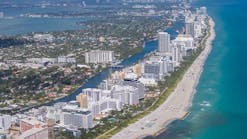Over the past seven years that I have been writing Clark’s Remarks, refrigerants have been a frequent topic. Refrigerant phase-out is a complex subject, balancing environmental impacts against cost, availability, safety, and efficiency.
If we treat toxicity and flammability as safety issues, then the primary environmental impacts are ozone-depletion potential (ODP) and global-warming potential (GWP). The worst offenders, chlorofluorocarbon (CFC) refrigerants, such as R-11 and R-22 that had very high ODP and GWP, were to be phased out between 1987 and 1996 under the terms of the Montreal Protocol. They were generally replaced by hydrochlorofluorocarbon (HCFC) refrigerants such as R-22. These had medium ODP and GWP, and were scheduled to be phased out over a much longer time frame, setting the stage for hydrofluorocarbon (HFC) refrigerants, such as R-134a and R-410a, to gain prominence.
The reduction targets for HFCs, that have zero ODP and medium GWP, were set by the Kyoto Protocol which the U.S. never actually ratified. Nevertheless, the U.S. EPA did continue to issue more restrictive rules relating to HFCs.
On January 1, 2017, the leak-rate threshold for previously exempted HFC refrigerants was lowered from 35 percent to 30 percent for industrial process refrigeration equipment, from 35 percent to 20 percent for commercial refrigeration equipment, and from 15 percent to 10 percent for comfort-cooling equipment. The following year (January 1, 2018), Section 608 of the Clean Air Act was amended to add HFCs to the list of ozone-depleting substances already restricted for sale to certified technicians, and to impose new reporting/record-keeping requirements for equipment containing 5 to 50 pounds of HFC refrigerants.
Now a U.S. Senate committee – the Environment and Public Works Committee – has taken action to establish a national policy to phase out HFCs. On September 10, 2020, with a bi-partisan vote, the committee agreed to amend the pending energy bill to phase out the production and importation of HFCs by 85 percent over the next 15 years. It remains to be seen if the measure will clear the full Senate, the U.S. House of Representatives, and then be signed into law by the President before Congress adjourns in January.
For those of us in the HVAC industry, the importance of using lower ODP and GWP refrigerants, and providing leak-tightness, has long been recognized by major green building rating systems like LEED and Green Globes. Regardless of the refrigerants used, they are only a problem when they leak into the atmosphere.
So, here's hoping for a green finish, at least, to an enormously challenging year.
A regular contributor to HPAC Engineering and a member of its editorial advisory board, the author is a principal at Sustainable Performance Solutions LLC, a south Florida-based engineering firm focusing on energy and sustainability. Contact him at [email protected].









